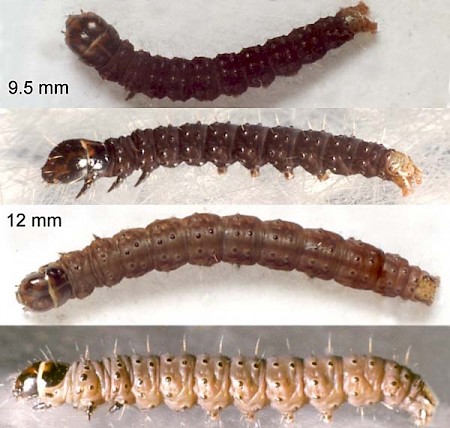
32.024 BF702
Agonopterix assimilella
(Treitschke, 1832)
Wingspan 15-21 mm.
A common moth throughout most of the British Isles, the adults of this species fly between April and June, and are sometimes attracted to mercury vapour light.
The foodplant is broom (Cytisus scoparius), the larvae living initially inside the stems, subsequently feeding externally.
The adults are rather similar to other Agonopterix species and can be difficult to determine without dissection.
- :
Foodplant: Cytisus scoparius. October to February in stem with entrance covered with silk. February to March or April between two green stems sewn together in parallel.
Intermediate instar (feeding externally)
Length: 9.5 mm described
Head: Brown ochre, heavily marked black dorsally and laterally.
Prothorax (T1): Large black prespiracular sclerite.
Prothoracic shield black with brown area at anterior. Divided by thin whitish medial line.
Thoracic legs: Femur, tarsus and tibia black. Base coloured as venter.
Body: Very dark brown dorsally and ventrally.
Spiracles: Unobtrusive.
Pinacula: Black.
Setae: Translucent, slightly tinted brown.
Anal plate: Yellowish with a few dark brown marks at bases of setae and elsewhere.
Prolegs: Dark brown. Distal half of planta yellowish brown. Anal prolegs yellowish brown.
Later instar
Length: 12 mm described.
Head: Brown ochre, heavily marked black dorsally and laterally.
Prothorax(T1): Large black prespiracular sclerite. Prothoracic shield black with brown
area at anterior. Divided by thin whitish medial line.
Thoracic legs: Femur, tarsus and tibia black. Base coloured as venter.
Body: Dark greyish brown (or greyish green; MBGBI) dorsally and ventrally. Slightly paler laterally.
Spiracles: Black, surrounded by ring of yellowish brown integument.
Pinacula: Black.
Setae: Translucent brownish.
Anal plate: Whitish yellow with a few dark brown marks at bases of setae and
elsewhere. Blackish band along lateral edge.
Prolegs: Coloured as venter. Wide pitchy brown collar on basal half of planta.
Similar species: On Cytisus scoparius:
Anarsia spartiella differs in having a black anal plate and strong black anal comb. It is at its larval stage in May and June after A. assimilella has pupated.
Agonopterix nervosa is very variable. Dark brown forms are usually markedly paler subspiracularly and ventrally. It is at its larval stage in May and June after A. assimilella has pupated.
Dull greenish grey specimens of Mirificama mulinella might possibly be mistaken for A. assimilella in April, when both species occur as larvae. But M. mulinella is at an early instar then, while A. assimilella is full grown. M. mulinella feeds in flowers, not from sewn parallel stems.

 UKMoths
UKMoths 





